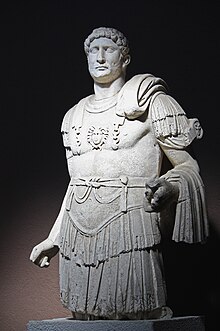Çanakkale Archaeological Museum
The Çanakkale Archaeological Museum ( Turkish Çanakkale Arkeoloji Müzesi ) is located on Ataturk Caddesi in Çanakkale in northwestern Turkey. It houses finds from all over Troas , including Troy .
history
A first collection of archaeological objects in Çanakkale was founded in 1936 in an old church building on Zafer Meydanı. This building was converted into a museum in 1959. In 1984 the present museum was finally built in Ataturk Caddesi.
collection
The museum displays artifacts from numerous locations during the Troad . These include reliefs, terracotta figures and ceramic products from Assos as well as from the temple of Apollo Smintheus in Chryse ( Gülpınar ), finds from Alexandria Troas and grave finds from the necropolis of Bozcaada , including imported ceramics from Attica and Corinth , but also amphoras found under water . Bronze cremation vessels, jewelry, gems, golden finger rings, wreaths and diadems, candlesticks, pieces of textile and sandals come from the tumulus of Dardanos . This also includes a terracotta statuette of Aphrodite , a copy of Aphrodite of Knidos . There is also a rich coin collection.
Objects from the new excavations in Troy since 1988 by Manfred Korfmann are exhibited in one part of the museum . The showpiece is a statue of the Roman emperor Hadrian , found in the Odeon there . The Troy I layer includes hand-made bowls, small vessels with lids, a 35 cm high water jug and weaving weights, Troy II ceramic objects from the potter's wheel and Troy VI Mycenaean and Miny ceramics . Everyday vessels from all layers as well as objects made of glass, crystal, bronze and ivory can also be seen.
Two Greek sarcophagi with reliefs are of particular importance: a sarcophagus depicting the sacrifice of Polyxena from Gümüşçay and a sarcophagus depicting hunting from the area around Çan .
In the outdoor area of the museum, sarcophagi, grave slabs, steles and amphorae from various parts of the Troad are exhibited. In a modern section, ceramic products from the Çanakkale region, which date from the 17th to the 20th century, are shown. Most of them belong to the type of earthenware (Turkish: çanak) that gave the city its name.
Web links
- Site of the Turkish Ministry of Culture
- Sarcophagus of Polyxena in the Arachne archaeological database
Coordinates: 40 ° 8 ′ 0 ″ N , 26 ° 24 ′ 36 ″ E

